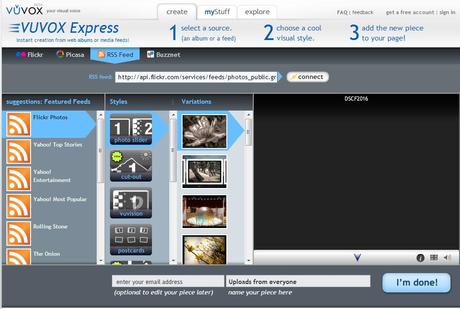1) Studio: This is Vuvox's most feature-rich presentation option. You can upload pictures, audio files, or videos from your computer, the web, Flickr, or Picasa, arrange them in whatever order you'd like, pick a style, customize it (if options are available for that theme), publish it, and voila! You have a brand-spanking new Vuvox presentation. Below is one I made (very quickly) as an example out of some of my racing pictures:
I know you dig the retro TVs as much as I do.
2) Express: As the name implies, this is a faster version of the Studio presentations editor. However, this option doesn't allow you to upload files from your computer--you can choose from Picasa, Flickr, an RSS feed, or Buzznet. You then pick your style and any variation on that style you like, and it generates a preview for you. Click "I'm done" and it publishes your presentation, generating a unique link and embed code. Below is a picture of the express option editing screen--as you can see, the express option really is "one stop shopping" for making presentations.
 The Vuvox Express editing screen
The Vuvox Express editing screen Here's an express presentation that I made in nanoseconds from what's popular on Yahoo! News (click on each picture and then look for a description at the top):
3) Collage: This is by far (to me, anyway) the most interesting type of presentation Vuvox offers. You can manually add pictures, video, or audio, or have it autofill with media from a variety of sources (pictures you've already uploaded, Smugmug, Picasa, Flickr). You can also add text in lots of funky fonts and colors, as well as what they call "hot spots" where you can link to other websites, add a text description, or add media. Below is a collage presentation I made about pre-assessments and how to use them to differentiate instruction so you can see the neatness that is Vuvox (press "play" or hover your mouse over the presentation to start it). Please note my feeble attempts at hot-spotting:
As with any presentation tool, it can be used for good (thought-provoking presentations that capture a viewer and won't let them shake loose) or evil (lots and lots of text waiting to be read to an audience). I can still see how students can use Vuvox to try and write everything they want to say into the collage format, or upload a lot of random pictures they found through a Google search into any of the Vuvox formats and call it a presentation (I see this a lot lately with how my students use Animoto). However, what I like about Vuvox is that it has the potential to be a pretty powerful presentation tool if used wisely, and I think it leaves room for a lot more creativity and expression. Here are some classroom-use ideas I had while concocting all of Vuvox's various presentations:
- Digital storytelling. The studio or collage presentations would be great ways to have students tell digital stories.
- RAFT assignments. Students could answer RAFTS in a visual, auditory, and text combination rather than just in writing.
- Concept collages. Students could put together digital collages that represent concepts, such as photosynthesis, nationalism, polynomials, or the elements of a good story. If using the collage option, adding "hot spots" to links or other media would be nice additions.
- Making connections. This is essentially the reverse of student-made concept collages. Using the express or studio option, teachers could create a photo collage representing a concept, and then students could discuss or write out what the unifying theme of all of the pictures are as well as what smaller concepts or details they represent--and how they are connected to the unifying theme.
- Cause and effect chains. When I do cause and effect, I often have a hard time getting students to think beyond just one effect for a cause--I like to have them "follow the logic" through to all possible effects (for example, listing all of the consequences in a logical order of agricultural runoff into bodies of water). The studio or collage presentations might allow them to make a cause and effect chain that is made of text and of visuals as well--and maybe with "hot spots" to other media to provide more information about those effects.
Those are just some ideas about uses for Vuvox that leaked out of my brain in the short time I've been using it; if you have more, please feel free to have them leak out of your brain into the comments. Overall, I feel Vuvox is a neat little tool with a lot of potential to make great presentations in a classroom.
